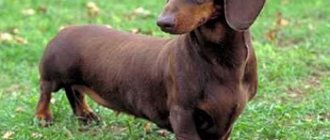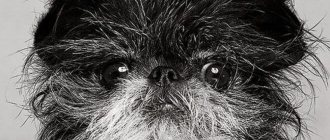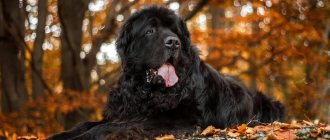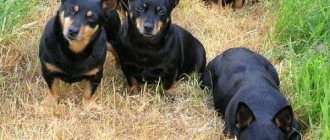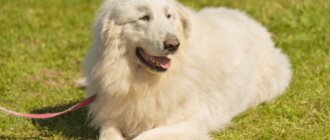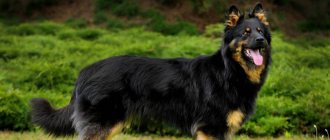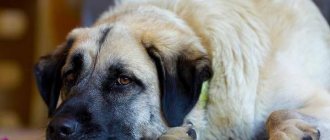Origin story
In Japan there is a legend about the origin of Kishu. It says that one day a hunter came out with a wounded she-wolf and, in gratitude for her help, he asked her for a puppy. The she-wolf fulfilled the request. This wolf cub was raised by a human and became the progenitor of all kishu. He was highly valued by hunters for his fearlessness, endurance and extraordinary intelligence.
Dog handlers do not believe the legends; they believe that Kishu descended from the indigenous Spitz-like Japanese dogs that appeared on the islands more than 3,000 years ago. How the Kishu breed was formed in the mountainous regions of the Kii Peninsula in the territory of the Kishu Principality. Hence its name. Today these are Nara, Mie and Wakayama prefectures. Hunting scenes involving muslin-like dogs date back to the 13th and 14th centuries.
The Kishu breed has been recognized as a National Treasure by the Japanese Dog Preservation Association Nihonken Hozonkai (Nippo).
For a long time, there were several types of dogs, which were called according to their place of origin: Kumano Inu, Taiji Inu, etc. The breed received the general name Kishu after official recognition and approval of the Nippo standard in 1934. At the same time, many other Japanese dog breeds were recognized. The breed was recognized by the International Canine Association (FCI) in 1982.
Usage
Kishu is a hunting dog, which is used mainly for hunting large game: wild boar, deer, bear. It is well suited to work in deciduous forests and mountainous areas. The tasks of the kishu during the hunt are to find the trail of the animal, track it and hold it until the hunter arrives.
If an animal tries to leave, the kitty will often jump on top of it and bite it with its teeth. However, she understands that she must only hold, and not kill. To do this, the dog must have sufficient courage, dexterity, strength and anger. Modern hunters often take a pair or a pack of dogs with them.
Unlike many other hunting dogs, the Kishu is capable of restraining the animal with both bark and bite.
A properly raised Japanese Laika develops a close bond with its owner. She is obedient, hardy and efficient, which makes her not only a wonderful assistant to the hunter, but a companion for various sports: agility, coursing, tracking.
In Japan, three intra-breed types are distinguished, depending on the object of hunting. The wild boar is hunted with strongly built, muscular dogs that have a special malice towards the animal. Deer are hunted if they are slender, easily excitable, and capable of long and fast running. Less common are small kishu with character and flair, which allows them to be used in working with small game and birds.
Large dog breeds
Akita Inu
Height: 61-70 cm.
Weight: 40-50 kg.
Country of origin: Japan.
This already world-famous breed appeared on the island of Honshu. She is the largest Spitz-type dog in Japan. Centuries ago, Akitas were taken to hunt large animals, incl. on the bear.
From the Japanese point of view, the history of the breed goes back more than 4 thousand years. Akita, by its genetics, is one of the oldest breeds in the world. Archaeologists have discovered cave paintings of similar dogs.
Today, the Akita Inu is widely used as a watchdog, fighting dog, and simply an excellent companion. The breed continues to develop and improve. There are many Akita clubs in Japan.
Longhaired Akita Inu
Height: 61-70 cm.
Weight: 40-50 kg.
Country of origin: Japan.
This is a type of Akita dog characterized by beautiful, long and thick hair. Especially long hair on the ears, tail and paws. In all other respects, these dogs comply with the breed standard.
American Akita
Height: 61-71 cm.
Weight: 45-55 kg.
Country of origin: Japan, USA.
For simplicity, Americans call this breed the Great Japanese Dog. Her parents are an Akitu Inu, a Mastiff and a German Shepherd. As a result, after crossing, an even larger and more powerful breed was obtained.
The world does not officially recognize the American Akita as a separate breed, but this does not prevent it from existing. American Akitas look very impressive, they are aggressive, but they themselves never attack first.
They can be red, like the Akitu Inu, but any coat color is allowed, most often a combination of gray or brown with white. The American Akita will withstand Siberian frosts, so the house where it lives should be cool.
Tosa Inu
Height: from 60 cm and above.
Weight: 35-61 kg.
Country of origin: Japan.
This is the only Japanese Molosser bred in the 19th century for dog fighting. For this purpose, local dogs were crossed with European mastiffs, St. Bernards, bulldogs, etc.
Japan almost does not sell its Tosa Inu to other countries; they end up in Europe or the USA most often from China. And these dogs first came to Russia in the 90s of the last century from South Korea.
This is an atypical breed for Japan - evidence of the beginning of cooperation between this closed civilization and the outside world. Today it is inferior to European, American or African fighting dogs, but continues to develop.
Appearance
Kishu is a medium-sized dog, strongly built, compact, and well-balanced. It has a wedge-shaped head typical of Japanese breeds, erect ears and a well-furred tail, which curls into a ring on the back or hangs down like a sickle. Sexual dimorphism is well expressed.
- Height at the withers of males - 52 cm, weight - 20-27 kg;
- The height at the withers of the bitches is 46 cm, weight is 14-23 kg.
The head is of proportional size with a wide forehead and a rather sharp stop. The muzzle is shaped like a tapering wedge. The nose is black; in white dogs it may be flesh-colored. The bridge of the nose is straight. Lips fit tightly. Scissor bite. The eyes are small, triangular in shape, dark brown in color, and widely spaced. The ears are triangular in shape, small, erect, slightly tilted forward. The neck is massive and muscular.
Body with strong bones and well-developed muscles. The height to length ratio is 10 to 11. The back is straight and short. The loin is wide. The chest is deep with moderately sprung ribs. The belly is well tucked. The tail is set high, reaching the hocks, thick, carried in a sickle shape or curled in a ring over the back. The limbs are straight, strong, with strong bones and joints. Paws with tightly knit toes, thick and elastic pads. The claws are strong, preferably black.
The coat is straight, coarse with a soft and dense undercoat. The hair on the cheekbones and tail is longer. Colors:
- White;
- Red (rich red);
- Sesame (sesame) - red or fawn coat with black tips on the hairs.
The brindle color has not been seen in the breed since 1945. Probably, its abandonment is due to the use of the dog for hunting. Whites are more noticeable in the forest and on the back of a dark animal.
Character and behavior
Kishu, like many other Japanese dogs, has an independent and balanced character. In everyday life he behaves calmly and calmly, but thanks to his flexible nervous system he is ready to immediately get to work when required. The Japanese Laika needs very good education and early, comprehensive socialization. Ignoring this can lead to behavior and obedience problems. Kisyu perceive any other living creature as prey, and are often pugnacious. Peaceful coexistence is possible only with those animals with which the dog grew up together, subject to proper upbringing.
Hunting behavior is very well developed. Kishu are brave and determined, quite easy to train, and show a passion for pursuit and anger towards the beast. They are highly territorial, making them good watchdogs. They do not have the ability to perform protective and guard duty. They are wary of strangers. They bark a little in everyday life.
The Japanese husky has an extraordinary intelligence, which is especially noticeable at work. When hunting, the dog shows unprecedented intelligence, and, if necessary, cunning. She can guard prey for a long time or change her work style if circumstances require it. Loyal to the owner. Attached to all family members, but rarely distinguished by outstanding fidelity.
Life expectancy and susceptibility to disease
The life expectancy of kishu reaches 14-16 years. Representatives of the breed are distinguished by good health and strong immunity, which is also facilitated by proper maintenance and a balanced diet. Since the breed was formed naturally, the dogs do not have a predisposition to genetic pathologies. The pet should be vaccinated and dewormed on time.
Kishu may experience hip dysplasia, allergic reactions, gastrointestinal disorders, and diseases of the organs of vision and hearing.
Content Features
Kishu are not demanding in terms of housing and nutritional conditions; they are unpretentious, hardy, have high adaptive qualities, and can easily tolerate cold. They are not adapted to city life and will not feel well in an apartment. The best option for a dog would be to live in a private home and use it for its intended purpose.
It is important for the Japanese Husky to have adequate living space, good exercise and the opportunity to hunt to satisfy its natural talents. If this is not a real hunt, she needs to find an alternative.
The dog does not require special care. Grooming comes down to standard care procedures:
- The coat is combed 1-2 times a week;
- Bathed once every 3-4 months or less;
- Ears are examined weekly and cleaned as needed;
- Claws are trimmed as they grow, if they do not grind down on their own;
- Monitor the condition of the eyes and teeth;
Kitty care
Caring for kitty is not difficult at all. A thick coat requires special attention, which needs to be combed regularly (once a week), removing dead hairs with a stiff brush. During the period of active molting, which happens twice a year, the procedure is carried out daily. There is no need to bathe your dog often; this is done as soon as it gets dirty, but not more than 2-3 times a year. Eyes and ears are examined weekly and wiped with special lotions or herbal decoctions. Teeth are brushed approximately once every 5–7 days. Nails are trimmed once every 3-4 weeks with special scissors.
Kishu-ken are not picky when it comes to nutrition; they happily eat whatever is offered to them. It is acceptable to feed them homemade food and dry store-bought food. A natural diet should consist of:
- lean meats (horse meat, veal, rabbit, beef, etc.);
- boiled offal (kidneys, lungs, liver, etc.);
- cartilage, scar;
- boiled vegetables (cabbage, zucchini, turnips, etc.);
- eggs;
- low-fat fermented milk products (yogurt, kefir, cottage cheese, sour cream);
- porridge (buckwheat, millet, barley, etc.);
- vitamin and mineral supplements.
When feeding with freeze-dried store-bought food, select products that are no lower than super premium or at least premium class (Akana, Hills, Purina Pro Plan, etc.). Adults are fed kisyu twice a day. Babies are given food more often - from two to six times, depending on their age.
It is better to keep kisyu in the yard of the house or in an enclosure
You can keep a Kisha Inu in an apartment, but a country house with a spacious, well-fenced yard or a large aviary and an insulated booth is most suitable for them. The breed needs a daily walk of at least an hour. Walks should be as active as possible so that the dog receives sufficient physical activity (running, jumping, going through an obstacle course, fetching, etc.).
Kishu are distinguished by their intelligence and intelligence. There have been recorded cases of dogs turning on the lights and opening the valves.
Training
Since kishu have a rather complex character, they need to be raised from as early an age as possible . Early socialization will greatly facilitate the process of subsequent training, which must begin after six months. It is difficult to train these dogs because they are stubborn and willful, they look for meaning in everything and never follow commands right away. This breed requires a subtle approach that excludes brute force.
Kitty training needs to be done constantly
Owning a Kisha Inu is recommended only for experienced dog breeders . A trainer who has experience working with Japanese dogs can help in establishing contact with the pet. Animals prone to leadership and dominance must unconditionally respect their owner, only then will they obey him.
Video: raising native dogs in Japan
Where to buy a Kishu puppy
In Japan, the Kishu population numbers 11,000-13,000 individuals. About 300 puppies are registered per year. Finding a Japanese Husky outside of Japan today is not difficult. A lot of dogs have been exported to Europe and the United States of America in the last 10-15 years. Given the growing popularity of Japanese breeds, it is not surprising that the number of dogs and breeders is growing every year. Japanese huskies are found in Russia, France, Spain, Germany, the Netherlands, Poland, Slovenia and some other countries.
Price
In Japan, the price of a Kishu puppy varies widely. Judging by the advertisements - 10,000-210,000 yen, the average is about 160,000 yen. (approximately $1,400). In Europe, they usually ask for 1,500-3,000 euros for a baby of a rare breed. In Russia, the average price of a puppy from nurseries is 100,000 rubles.
Choosing a puppy
Even in Japan itself, Kishu is considered a rare and not very widespread breed . In other countries, there are only a few kennels that professionally breed these dogs. In our country, Kishu Inus are extremely rare, and it is very difficult to buy a puppy.
It is difficult to buy kitty puppies
The baby Kishu can be confused with other Japanese dogs, our huskies and simply similar outbred dogs. Only highly specialized dog handlers, of whom there are only a few, will be able to understand all the intricacies, and they all live in Japan. Therefore, you need to purchase a puppy exclusively from a reliable, trusted breeder with good recommendations and positive reviews. He must provide the necessary package of documents (pedigree up to the fifth generation, puppy card, veterinary book with notes on vaccinations, hunting diplomas of parents, etc.), which will confirm the thoroughbred of the animal.
In Russia, Kisyu puppies can be purchased in nurseries: “Nord Fantasy”, SNOW GALAXY, “Kryazh Yakutii”. The price for Japanese Kishu Inu dog puppies starts from 100 thousand rubles.

